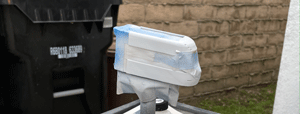Last month we reported on the latest addition to the Norristown High Speed Line (NHSL) originally the Philadelphia and Western Railway (P&W). This issue will concentrate on the rich history of this railroad, the only standard gauge light rail line in the Philadelphia area.
The P&W was originally planned as the proposed eastern link of a transcontinental railroad connecting to the Western Maryland Railroad at York, PA. The first train ran from 69th Street to Strafford on May 22, 1907. On June 6, 1907, the company defaulted on the payment of first mortgage bonds it had issued, so the company was sold at public sale by the bond trustee for $1,000,000 to the Sheldon Syndicate of New York, which was the original owner of the company. The planned extension to Parkesburg and York was officially abandoned on March 22, 1912, An alternate extension to the PRR main line in Strafford opened on October 11, 1911. The Norristown Branch opened on December 12, 1912.
The railroad built a 20-acre amusement park called the Beechwood Amusement Park in the Powder Mill Valley in 1907 to provide a potential destination for riders, The park opened on May 30, 1907 and could accommodate 15,000 people and included 10 acres of rides, picnic grounds, and a lake with rowboats for rent. The park had 5,000 visitors on the opening day but began losing money almost immediately after opening due to competition from other parks in Willow Grove, Chestnut Hill, and Washington Park. The railroad finally abandoned the park in 1909.
The first cars built for the P&W never actually ran on the P&W, since the cars were completed before the line was ready to open. Twenty-two wooden electric multiple-unit passenger cars and two full-baggage-configured MU's were built for the P&W by the St. Louis Car Co. in 1906. However, due to the San Francisco earthquake, twelve of them went to MUNI predecessor United Railroads of San Francisco (URR of SF), four went to the Sacramento Northern (SN) Railroad, and the remaining ten went to the Erie Railroad Rochester-Mt. Morris Branch, where they were modified and rewired for overhead AC operation. The twelve cars that went to URR of SF had their bulkhead doors sealed and their MU capabilities removed, operating strictly as single-units. The four SN cars were converted into motorized combination baggage/passenger cars and used on the Woodland Branch. The two baggage cars were accepted by the P&W, where they were turned into line-maintenance cars.
Finally in 1907, twenty-two wooden passenger cars, almost identical to the original order, arrived on P&W property. They were originally equipped with rectangular-shaped bow collectors, which were later replaced with trolley poles for use in the car barn area in addition to third rail shoes.
Of those 22 cars, No. 46, shown above operating on the now defunct Delaware Avenue Penn's Landing Trolley (1982 to 1996) survives, along with line car No. 401 from the original order; both of which are preserved at the Electric City Trolley Museum in Scranton, PA. Prior to the move to Scranton, they ran as a two-car train while in operation at the Philadelphia Waterfront every Christmas season for many years as the "Santa Train," with No. 401 operating as Santa's workshop and No. 46 used for the passengers.
Car 46 survived after serving as work car 446 for many years visible to all sitting outside the 72nd street shops.
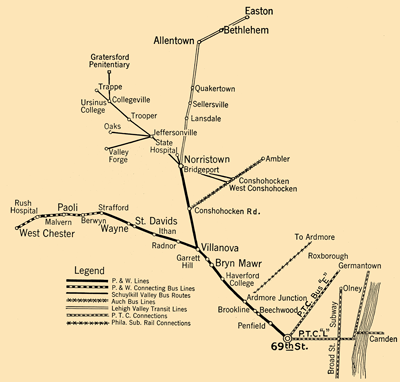 The Philadelphia & Western Railway in 1941. The Philadelphia & Western Railway in 1941. |
The P&W ran what were called the "Bullet cars" because of their shape and speed. The all-aluminum Bullet cars were the mainstay of the line from 1931 until 1990.
The current SEPTA Norristown High Speed Line (NHSL) began in 1907 as the Philadelphia & Western Railroad (P&W), which ran from the present 69th Street Terminal in Upper Darby, PA to a converted farmhouse station in Strafford PA. In 1911, the line was extended 0.47 miles (0.76 km) west to a new Strafford P&W station adjacent to the Pennsylvania Railroad's Strafford station, allowing easy interchange between the two lines. In 1912, a 6.2-mile (10 km) branch was constructed from Villanova Junction, 0.33 miles (0.53 km) west of the existing Villanova station, to Norristown. When the newly built branch quickly attracted more ridership than the Strafford main line, the Norristown section then became the main line and the Strafford stretch was demoted to branch status; in the mid-1930s, the Strafford spur was narrowed to a single track for its last 1.74 miles (2.8 km) between the Wayne-St. Davids and Strafford stations, while the Norristown line received a sleek new art deco terminus at Main and Swede Streets. Service to Strafford was finally abandoned on March 23, 1956.
The line is entirely double track except for the bridge that crosses the Schuylkill River. In a few places there are three tracks. The shops, referred to as the 72nd St shops, are located adjacent to the 69th Street Transportation Center, on the left side of the tracks as you head towards Norristown.
The first large group of cars built for use on the then new Strafford line were named the "Strafford Cars" and these 11 cars were built by the J.G. Brill company of Philadelphia. Three similar cars, called the 50-series, were purchased 1920 and these cars actually opened the line. They were several inches wider and several feet longer than the later Straffords and never had vestibule steps but had trolley poles so they could be used on the branch to Norristown.. They were never rebuilt, so with their top speed still only 45 mph (72 km/h), they had to be used strictly in rush hour short-turn service so they wouldn't get in the way of the other much faster trains. They were finally scrapped in 1952. Maximum speed was 44 miles per hour, and the cars featured smoking compartments, parcel racks, and train doors for easier passage between trains of more than one car. The P&W was pleased with the first car #60, and subsequently ordered 5 more cars (61-65) in 1927, followed in 1929 by 5 additional cars (66-70), bring the total fleet of 60 cars to 11 by 1929, one of which is shown below left. The last Strafford Car was retired on March 30, 1990.
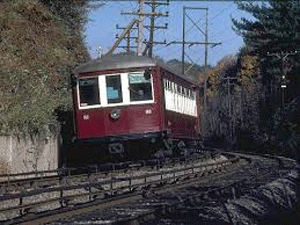 |
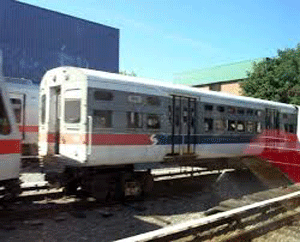 |
Before the new cars arrived beginning in 1991, various pieces of equipment from Chicago and Philadelphia were used on the line. Above right is one of the seven married pairs of the 6000 series of Chicago Transit Elevated cars (obtained very. cheaply) that allowed the line to resume full service in December 1986 after the line had to be shut down in August 1986 when the number of available cars were insufficient to maintain service. The line also used five former single unit M3 Market Frankford Subway Elevated (MFSE) 1960 era "Almond Joy" cars beginning in 1989.
The two former CNS&M 'Electroliners' 801-802 and 803-804, shown in the center and right photos below, came to the NHSL in 1964. The trolley poles and steps were removed, new doors were added in the center coach sections, and updated third-rail contact shoes were installed. They emerged from the shops in the then "Red Arrow" colors of cream and maroon as shown the below right photo. The tavern-lounges continued in service, providing coffee and pastry in the morning, and beverages and snacks in the evening. 801-802 was renamed "Valley Forge", while 803-804 became "Independence Hall". They were retired in 1978 and both survive in museums.
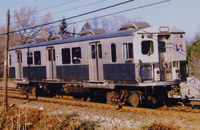 Almond Joy 601 on the NHSL. Almond Joy 601 on the NHSL. |
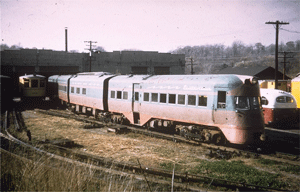 Electroliner still in Chicago livery. Electroliner still in Chicago livery. |
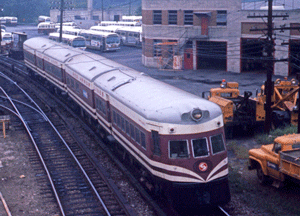 Electroliner in LibertyLiner livery. Electroliner in LibertyLiner livery. |
The 26 single unit ABB N-5 cars which replaced the Bullet cars were originally considered a light rail vehicle, but because of its separated right-of-way, high platforms, and 3rd rail supply, it is now considered a "heavy rail interurban line" and SEPTA renamed it the Norristown High Speed Line in September of 2009. Prior to that, it was known as Route 100, and many still refer to it as the "old P&W".
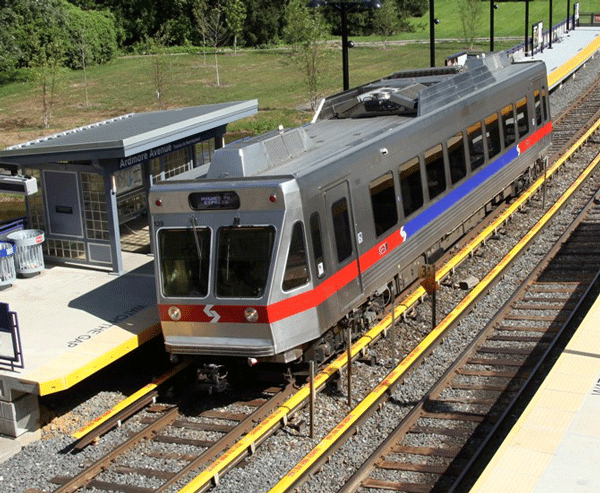 |
Besides the system being unique in many ways, the cars are unique in their own right, as they are only the second set of cars made by Asea Brown Boveri (ABB) in the United States, sharing the same technology as the Baltimore LRV's - not just similar, but the exact same, with things like the propulsion modules, auxiliary modules, etc, being interchangeable with the ones on the Baltimore cars. ABB Traction (now Bombardier) delivered N-5 No. 451 in 1991. The production fleet arrived in 1993. No. 451 was then renumbered 130. Additionally, six cars more than required for 69th St. to Norristown service were purchased to provide expansion capacity for the King of Prussia (KoP) extension. It isn’t out of the realm of possibility that the now 27-year-old N5s will not see KoP, but their replacements now will.
The extension will leave the Route 100 alignment north of the Hughes Park Station and the Pennsylvania Turnpike. Three operations will be provided: 69th Street Terminal to King of Prussia, King of Prussia to Norristown Transportation Center, and the current 69th Street to Norristown operation. Representatives from the project planners and SEPTA made a detailed presentation. Throughout the planning process, stretching over more than two decades, business, government representatives at Federal state, and local levels and residents have been intimately engaged in the process.
Twenty-one different alignments had been proposed and withdrawn in response to concerns about construction disruption associated with an alignment along US Route 202, DeKalb Highway and other proposals that would have caused acquisition of many private homes and noise and visual issues along different proposed alignments. The current proposal has alleviated all private resident concerns and virtually no homes will be impacted. Unfortunately, responding to these local concerns has enhanced community buy-in but has resulted in a lengthy delay which has increased the projected cost from roughly $450 million (2000) to almost $2 billion (2020), a hefty price tag for a four-mile route. Usually around 20-25% of the cost of a transit extension is for rolling stock but planners claim that purchase of only four additional vehicles is needed to supplement the N-5 fleet, which might be optimistic, especially since the earliest introduction of service will be in 2025, at which time the N-5 fleet will be almost 35 years-old.
The alignment will have five stations and will serve the Henderson Road shopping complex, the King of Prussia Mall complex with shuttles to the new entertainment and dining venues at the King of Prussia Town Complex and additional commercial, residential and development space. The route will end near a hotel and casino complex with easy access to Valley Forge National Park. Together these comprise some of the largest retail and entertainment venues in the United States with more square feet of retail space than Center City Philadelphia and the highest concentration of entry level jobs in the region. Already more than 60,000 people work in King of Prussia, a number expected to grow by at least 30% in the next 15-20 years. The area is served by six SEPTA bus routes which must contend with local traffic, including the Schuylkill Expressway (I-76) and consequently have the worst on-time performance of any routes on the SEPTA system. King of Prussia is vibrant and growing but is totally automobile dependent. It is a magnet for students from local colleges along the old Main Line, including University of Pennsylvania, Bryn Mawr, Haverford, Rosemont and Villanova. The line will be an engine for transit-oriented development-residential, commercial, retail, and entertainment.
Success will depend on frequent and free shuttle bus service linking the route to various destinations including King of Prussia Town, the large Children’s Hospital of Philadelphia satellite on Upper Gulph Road, and the theatre complex between the King of Prussia Mall and the Pennsylvania Turnpike. Schedulers will need to acknowledge that peak ridership to a mall complex is unlike usual weekday peak service. Demand will be high in mid-afternoon, late evenings, and weekends when shoppers, retail workers and entertainment seekers travel to and from the area. Planners will be well advised to review the scheduling and operations of other rail projects serving large suburban retail and commercial agglomerations, including Mall of America in the Twin Cities, South Hills Village outside of Pittsburgh, and the large mall that will be served by the Edmonton Light Rail operation. The trough design of some of the elevated structure may complicate issues like snow removal. Nonetheless, this is the highest priority transit project in the greater Philadelphia area, has enormous promise as a job generator, source of transit-oriented development, traffic mitigator, and environmental and quality of life enhancement. A no-build option would leave the King of Prussia area totally car dependent. For information about the project, visit their web site https://www.kingofprussiarail.com/
